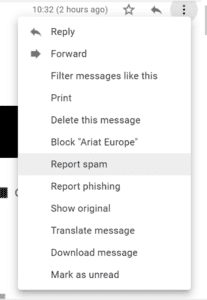
Why aren’t my emails reaching the inbox?
You could craft the most perfect, persuasive email marketing campaign in the world – but it will fail miserably if nobody sees it.
Your campaign’s deliverability – i.e. its chances of reaching the right audience – depends a lot on your sender reputation. Your sender reputation is set by the ISPs (Internet Service Providers, such as Gmail, Outlook, Yahoo), based on your past sending behaviour. If you’ve been spammy, scammy, or just plain uninteresting in the past, the IPs will protect their customers by lowering your sender reputation. This makes it a lot harder for you to reach the inbox.
However, if you’ve been sending high-quality, engaging content that customers love (through opens and clicks in your campaign), your sender reputation will rise, and you’ll hit the inbox every time.
How can you achieve this stellar sender reputation? Well, we have a few key tips for deliverability. Let’s walk through it together.
How can you achieve this stellar sender reputation?

1 – Be seen
If your engagement metrics are down, such as the click-through rate, it could be because nobody is seeing your emails. Why? It could be due to one of these factors:
- Bounce rates – There are two kinds of email bounce – ‘hard’ and ‘soft’. Unless they happen over and over again, ‘soft’ bounces aren’t too much to worry about. Hard bounces are a different story. If you’re getting hard bounces, the ISPs will take it as a sign that you’re not regularly cleaning your list. And that’s the kind of thing ISPs hate.
- Spam reports – Generally, ISPs give some margin for error. They know that a few spam reports are inevitable when you’re sending promotional content. But if you get a whole bunch of spam reports, they won’t hesitate to trash your sender reputation.

- Blacklists – There are hundreds of blacklists out there, but only a few major ones really matter. These are:
- CBL (Composite Blocking List)
- SBL (Spamhaus Block List)
- XBL (Exploits Block List)
- Spamcop
- PSBL (Passive Spam Block List)
- Invaluement
- Barracuda
- Senderscore
Tools like MXtoolbox will let you know if you’re on a relevant blacklist. Then, you simply message the owner of the list and explain yourself.
2 – Be opened
If everything seems fine with your sender reputation but your engagement rates are still low, it’s time to accept a hard truth: your customers just aren’t that into your content.
Don’t worry – it happens to the best of us! Time to get optimising:
Segment and automate
If personalising every customer’s subject line sounds like an impossible task, that’s because it is.
Well, impossible manually, anyway.
For automation, nothing is impossible. All they need is the right data, presented in the right way.
If you have data on your customers’ age, name, location, interests, preferences, and so on, automation can easily take that data and run with it.
All you have to do is segment your customer list according to relevant data points, craft templates for each data point, and leave the rest up to the machines.
For example, to personalize a subject line by location, you would first sort your list according to where customers lived. So, you might have one segment of customers in New York and another in London.
You would then craft two template subject lines – one with a New York-based offer, and one with a London-based offer.
And hey presto! A personalized campaign is born!
With automation, you can get a lot more granular and complex than this example. Look into what the machines can do for you!
For automation, nothing is impossible. All they need is the right data, presented in the right way.
3 – Be engaged with
Now it’s time to do the same for your email content.
If clickthrough and conversion rates remain low, ask yourself the following questions:
- Is my content relevant? Consumers won’t slog through an email that’s not relevant to their lives, their needs, or their interests. Look into what your customers want, and give it to them.
- Is my template enticing? Something as simple as template design can make all the difference. Blocks of tight, dense text are offputting. On the other end of the scale, an email crammed out with flashing gifs and images is equally offputting. Work on a clear design that gets your point across without overwhelming your customer.
- Does my email work on mobile? Optimizing for mobile is a must. Make sure that your email is just as accessible on a small screen via 4G as it is on a PC via strong wifi.

4 – Be reported
As you tweak, refine, and optimize, it’s important that you know what’s working and what isn’t.
To do this, you need to dig into your analytics. Look at metrics like:
- Clickthrough rate – If a high percentage of recipients are clicking on your CTA, that’s a good indicator that your content is working. Keep doing what you’re doing!
- Unsubscribe rate – A rising unsubscribe rate isn’t always a bad thing – but if your unsubscribe rate spikes during a particular campaign, you should probably take the hint.
- Complaints/spam flags – If recipients find your content spammy, your sender reputation will suffer. Work on making your content more relevant for your customer.
- Engagement rate – If people are reading, responding to, clicking on, and generally engaging with your email, that is a great sign. IPs take engagement as a sign that your content is valuable for the customer, and will raise your sender reputation accordingly.
Raise your sender reputation and hit the inbox every time
All in all, your sender reputation is pretty important. The key to raising it is through paying attention to your customers, keeping your list nice and clean, and sending out the kind of content your customers want.
This might also interest you?
-
No-reply emails are (not) the answer
No-reply emails are (not) the answer
-
DOI reminders: essential or excessive?
When it comes to email marketing, the double opt-in (DOI) process remains a core pillar for establishing trust with your subscribers.
-
Emails Accessible: Ensuring Readability for Everyone
By leveraging the right email flows, franchises can create a unified brand experience while catering to local market needs. Discover more.

Let’s talk!
Whether you’re looking for a new platform, a partnership or just want to have a cup of coffee and a chat: we’d love to hear from you.
